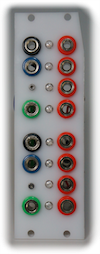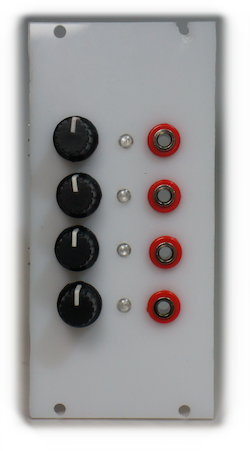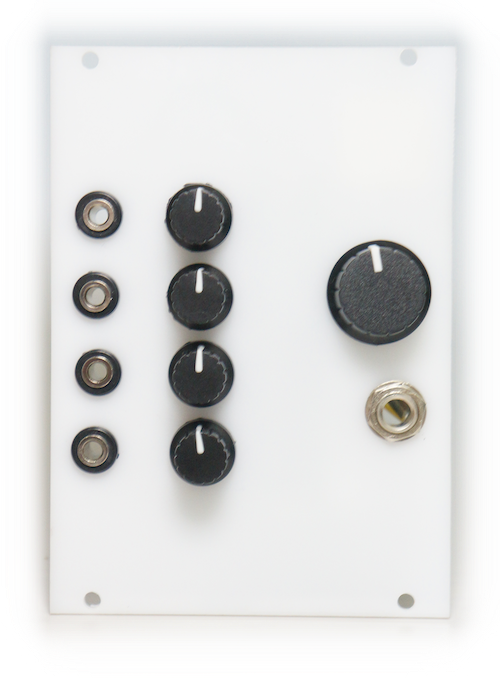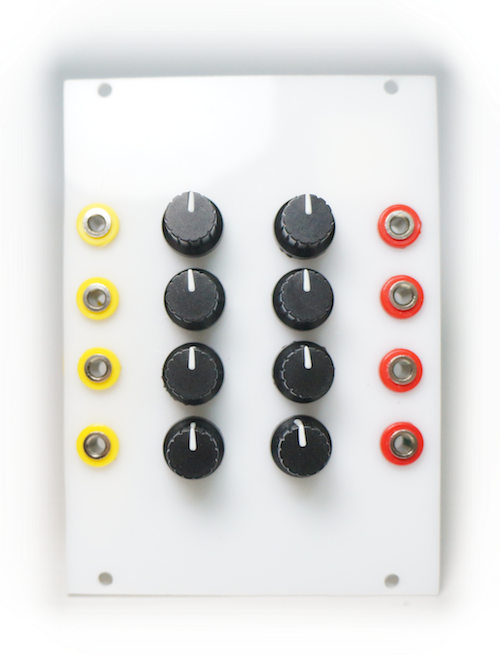-
MODULE 005 – R-2R
02/09/2015 at 04:44 • 0 comments![]()
R-2R is two "R-2R ladders" in a tight 6HP package. The four inputs act as a 4-bit analog to digital converter that is perfect for generating stepped waveforms to drive oscillators as a CV source or to create more nuanced sounds than the raw square-waves everything has been putting out till now.
The article gets really tucked into DC analysis as we pick apart how and why the R-2R ladder works. You will be sick of Ohm's law by the end of it, but you should also never have to read up about it again!
– 6HP
-
MODULE 004 – Dual Shift Register
02/09/2015 at 04:37 • 1 comment![]()
Two deceptively powerful and useful little tools tucked in nice and tight on a small panel. Chain them together for a larger 8-bit register!
The article covers what shift registers actually are, a tiny sampling of their many uses and a look into a circuit building block that we'll be getting very familiar with – the leading edge detector. There is also what I hope will be the last of my woes from working with the acrylic for the front panel.
– 8HP
-
MODULE 003 – 4xLFO
02/09/2015 at 04:13 • 0 comments![]()
Four square wave LFOs with little blinky lights to show you how fast they are going. Endless fun. Just don't stare into them too long or you will hurt your eyes.
This article is very short as the insides of this module are just the same as 001 – 4xSQUARE, only with bigger capacitors. However, I ran into a few problems while making it, which I write about briefly, mainly to do with drilling and measuring out panels – both of which I ballsed up terribly...
– 12HP
http://castlerocktronics.com/modular/articles/CR-003_-_4xLFO.pdf
-
MODULE 002 - Output Mixer
02/09/2015 at 04:04 • 0 comments![]()
The other thing you can't not have is some way to get the sounds together on one cable and out to an amp or your computer. That's exactly what this module is for, with a little added extra: built in overdrive! 4 channels that are summed together and stepped down to line-level so you don't blow anything up & smooth, but gritty overdrive for when you want to get aggressive. Very nice when you have pulsing ambient drones going on.
In the article we cover op-amps as inverting amplifiers (and summing amplifiers), using op-amps on a single-rail power supply as well as decibels and how diodes in an op-amp's feedback loop create clipping.
– 18HP
-
MODULE 001 – 4xSQUARE
02/09/2015 at 03:59 • 0 comments![]()
You can't have a synth, modular or otherwise, without oscillators! But why have one when you can have four? This is a slight twist on the popular 40106 oscilator bank, with very simple CV control of the oscillators added with diodes. Very low parts count, a nice easy build.
In the article we cover why it oscillates, as well as why the diode allows for pitch control and gating. On top of that, we figure out how to calculate the pitch of the oscillators and how to figure out where the gating effect of the diode kicks in.
– 18HP
-
MODULE 000 – Power & System Overview
02/09/2015 at 03:29 • 0 comments![]() The only module you will use 100% of the time. It's slightly dishonest to call it a power supply though, as really you use a DC wall-wart as the power supply, this is just a switch, an LED and a bus board. It uses generic connectors DIP spaced connectors (XH-2.54 type) to allow for easy attachment and detachment of modules for rearranging. There is a fuse so you can ignore current draw till it blows and then be thankful you had a fuse since you weren't tracking current draw (it's very low though). Also includes a daisy-chain output for powering guitar stompboxes off the same power supply and an external ground connection for interfacing with other synths and gear.
The only module you will use 100% of the time. It's slightly dishonest to call it a power supply though, as really you use a DC wall-wart as the power supply, this is just a switch, an LED and a bus board. It uses generic connectors DIP spaced connectors (XH-2.54 type) to allow for easy attachment and detachment of modules for rearranging. There is a fuse so you can ignore current draw till it blows and then be thankful you had a fuse since you weren't tracking current draw (it's very low though). Also includes a daisy-chain output for powering guitar stompboxes off the same power supply and an external ground connection for interfacing with other synths and gear.There is also a general overview of the system, including the colour scheme for the banana jacks, some generic circuit building blocks like input and output protection, and what the general ethos of this DIY project is.
– 4HP
CMOS Modular Synthesizer
Low-cost, high-effectiveness DIY modular synthesizer system aimed at beginners
 Castle Rocktronics
Castle Rocktronics




 The only module you will use 100% of the time. It's slightly dishonest to call it a power supply though, as really you use a DC wall-wart as the power supply, this is just a switch, an LED and a bus board. It uses generic connectors DIP spaced connectors (XH-2.54 type) to allow for easy attachment and detachment of modules for rearranging. There is a fuse so you can ignore current draw till it blows and then be thankful you had a fuse since you weren't tracking current draw (it's very low though). Also includes a daisy-chain output for powering guitar stompboxes off the same power supply and an external ground connection for interfacing with other synths and gear.
The only module you will use 100% of the time. It's slightly dishonest to call it a power supply though, as really you use a DC wall-wart as the power supply, this is just a switch, an LED and a bus board. It uses generic connectors DIP spaced connectors (XH-2.54 type) to allow for easy attachment and detachment of modules for rearranging. There is a fuse so you can ignore current draw till it blows and then be thankful you had a fuse since you weren't tracking current draw (it's very low though). Also includes a daisy-chain output for powering guitar stompboxes off the same power supply and an external ground connection for interfacing with other synths and gear.